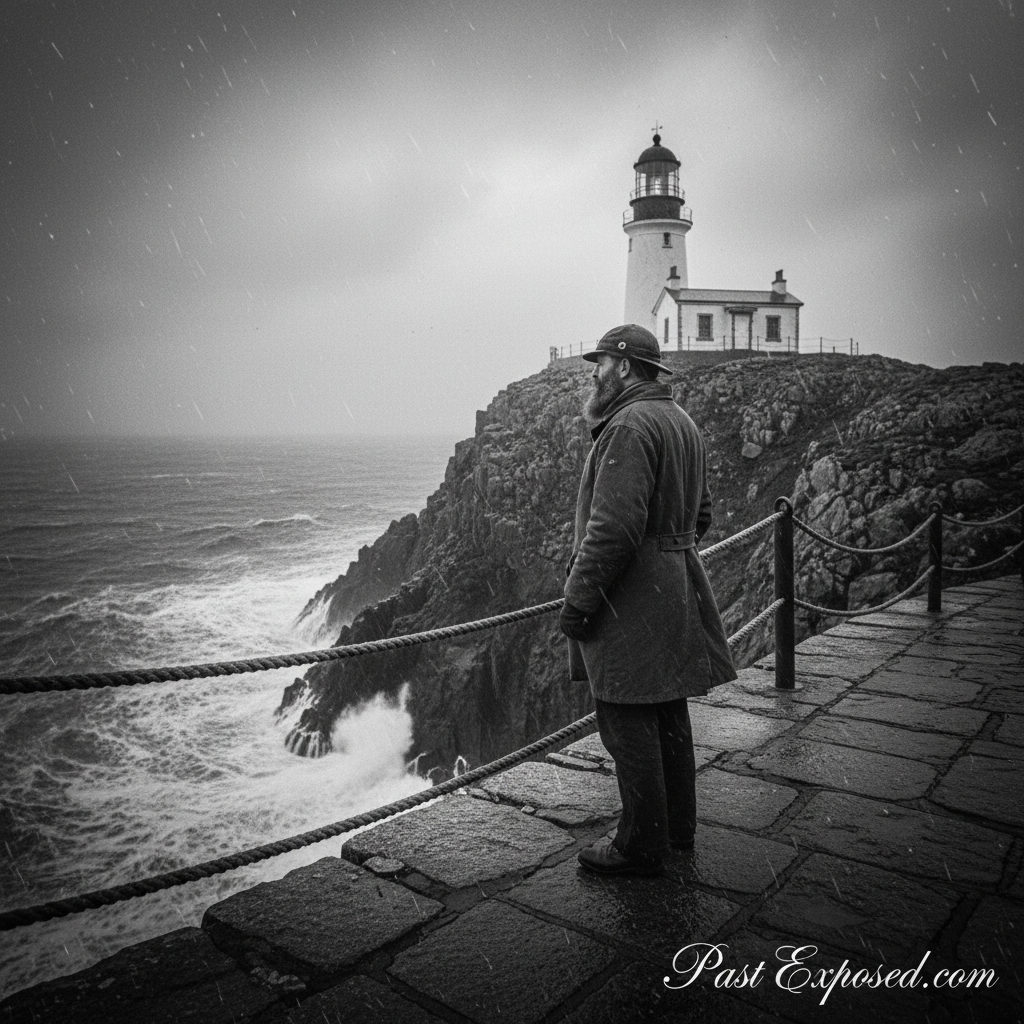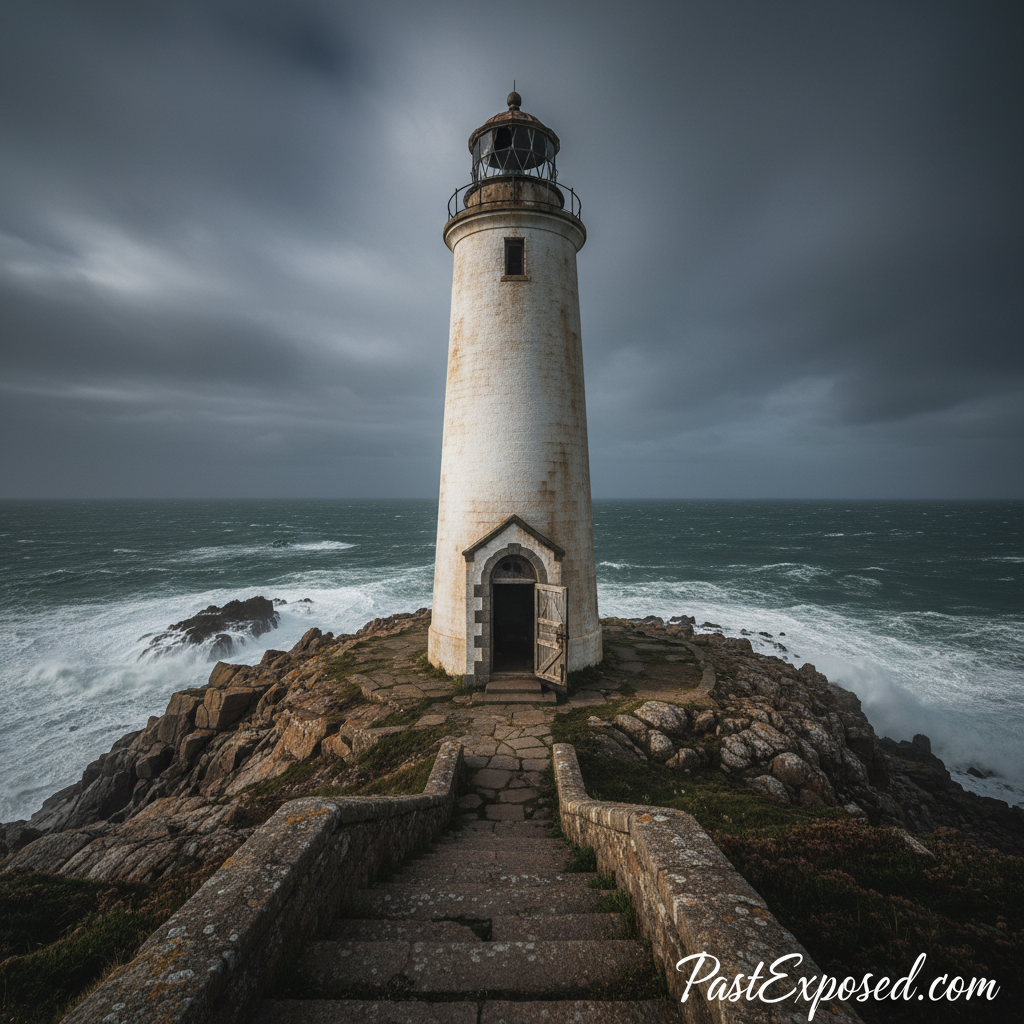On the cold morning of December 26, 1900, a routine supply ship approached the remote Flannan Isles lighthouse off the coast of Scotland. What awaited the crew aboard the Hesperus was not a warm welcome, but an eerie silence that would spawn one of maritime history’s most haunting unsolved mysteries.
The Flannan Isles, known locally as the “Seven Hunters,” rise like ancient sentinels from the churning Atlantic waters, seventeen miles west of the Isle of Lewis. These forbidding rocks had witnessed countless shipwrecks throughout history, their jagged shores claiming vessels and souls alike. It was precisely to prevent such tragedies that the Northern Lighthouse Board constructed a lighthouse on Eilean Mor, the largest of the islands, completing it in December 1899.
The Last Known Contact
Three experienced lighthouse keepers maintained the beacon: James Ducat, the Principal Keeper, a veteran of the lighthouse service; Thomas Marshall, the Second Assistant; and Donald MacArthur, the Occasional Keeper. On December 15, 1900, the passing steamer Archtor noted that the Flannan Isles light was not operating—the first ominous sign that something was terribly wrong.
However, due to severe weather conditions that prevented any vessel from approaching the island, it would be eleven days before anyone could investigate. The lighthouse remained dark, its beam absent from the treacherous waters it was meant to protect.

The Discovery
Captain James Harvey of the relief vessel Hesperus arrived at Eilean Mor on the morning of December 26. The ship’s horn echoed across the cliffs—no response. A flare was fired into the grey sky—still nothing. An uneasy feeling settled over the crew as they prepared to land.
Joseph Moore, the relief keeper, was sent ashore. As he climbed the steep steps carved into the rock face, he noticed the entrance gate and main door were both closed—unusual, as protocol dictated that one keeper should always be ready to greet arriving vessels. Moore entered the lighthouse and called out. His voice echoed through empty chambers.
The scene inside was utterly perplexing. The kitchen table was set for a meal that was never eaten. Two of the three oilskin coats—essential protective gear for the brutal Atlantic weather—were missing from their hooks. But most disturbing was the clock in the entrance hall: it had stopped.
The Logbook’s Final Entries
Moore discovered the official logbook, and its final entries sent chills down his spine. Thomas Marshall had made notations describing a severe storm on December 12—but weather records from nearby areas showed December 12 had been calm. The entries grew increasingly strange:
“December 12: Gale north by northwest. Sea lashed to fury. Never seen such a storm. Ducat very quiet. MacArthur crying.”
“December 13: Storm still raging, wind steady. Ducat irritable. Prayed.”
“December 15: Storm ended, sea calm. God is over all.”
These were the last words recorded. Three experienced keepers, men who had weathered countless storms, had vanished without trace.
The Investigation
A thorough search of the island revealed more disturbing clues. At the west landing, over 200 feet above sea level, damage suggested massive wave action—a section of railway track used for transporting supplies had been ripped from its concrete bed and twisted like ribbon. A life buoy had been torn from its mounting. A wooden box containing mooring ropes, normally stored 110 feet above sea level, had been completely destroyed.
Yet this evidence created more questions than answers. Could three experienced keepers have been swept away simultaneously? Why would all three men have gone to the landing platform together, violating the fundamental rule that one keeper must always remain inside the lighthouse?
The Northern Lighthouse Board’s official investigation, led by Superintendent Robert Muirhead, concluded that the men had been swept away by a massive wave while attempting to secure equipment at the landing stage. But the theory had significant flaws. The missing oilskin coat suggested the tragedy occurred in three stages—if all three men had gone out together, why wasn’t the third coat also missing?
Theories and Speculation
Over the decades, numerous theories have emerged, ranging from the rational to the fantastical:
The Rogue Wave Theory: A massive, unexpected wave swept all three men into the sea. But this fails to explain why experienced keepers would all leave their post simultaneously, or why they would go out during dangerous conditions.
The Accident Theory: One keeper fell, and the other two died attempting a rescue. This explains why they might have all been outside, but doesn’t account for the strange logbook entries or the violation of protocol.
The Murder-Suicide Theory: Isolation drove one keeper mad, leading to violence. However, no evidence of struggle was found, and the lighthouse was in perfect order.
The Supernatural: Local folklore spoke of the Flannan Isles being haunted, home to ghostly ships and phantom birds. Some islanders believed the keepers had been taken by supernatural forces—a theory that persists in local legend but offers no rational explanation.
The Psychological Element
Perhaps most haunting were the logbook’s descriptions of the keepers’ mental states. These men were professionals, trained to remain calm in crisis. Yet Marshall described Ducat as “irritable” and “very quiet,” while noting that MacArthur was “crying.” In the rigid, stoic world of 1900s lighthouse keeping, for a man to record such emotional observations suggested something deeply disturbing had occurred.
Some researchers have suggested the men experienced a shared psychotic episode, possibly induced by isolation, fear, or even contamination of their food or water supply. The phantom storm—recorded by Marshall but not appearing in any weather records—could have been a mass hallucination or delusion.
The Legacy
The Flannan Isles lighthouse continued to operate with new keepers, though many who served there reported feelings of unease, unexplained sounds, and a persistent sense of being watched. The lighthouse was finally automated in 1971, removing the need for human keepers.
The mystery inspired the haunting poem “Flannan Isle” by Wilfrid Wilson Gibson in 1912, which helped cement the story in popular imagination. More recently, the 2018 film The Vanishing offered a fictionalized interpretation of events, though the true story remains far more chilling than any screenplay.
Today, the lighthouse still stands on Eilean Mor, its automated beam sweeping across the same dark waters that witnessed the keepers’ disappearance. The islands remain largely uninhabited, visited only occasionally by maintenance crews and adventurous tourists willing to brave the dangerous seas.
Unanswered Questions
More than 120 years later, the fate of James Ducat, Thomas Marshall, and Donald MacArthur remains unknown. Were they victims of the sea’s unpredictable fury? Did they experience some psychological break that led to their deaths? Or did something else—something we may never understand—occur on that remote island in December 1900?
The logbook’s final phrase echoes through time: “God is over all.” Whether this was an expression of faith, a plea for protection, or something else entirely, we will never know. The Atlantic keeps its secrets well, and the Flannan Isles lighthouse stands as a stark reminder that even in the modern age, some mysteries remain forever unsolved.
The three keepers are commemorated on a memorial plaque in Scotland, their names preserved even as the truth of their disappearance remains shrouded in the mists of time and the endless roar of the Atlantic waves.
The sea gives up some of its dead, but not all. And on winter nights, when storms lash the Flannan Isles, some say you can still see three figures standing at the west landing, forever watching for a wave that will never come—or perhaps, has already taken them.

